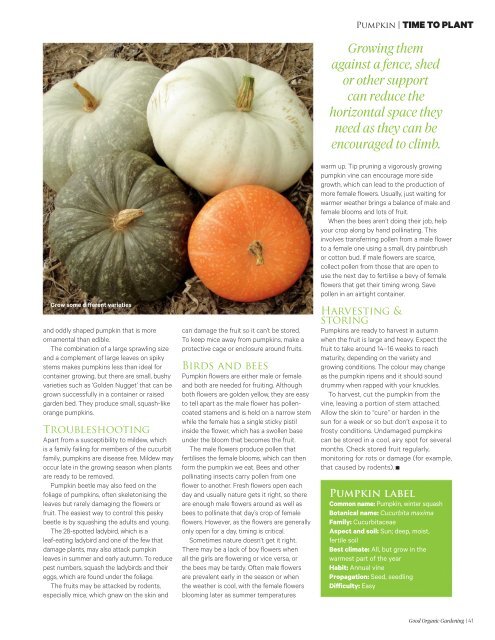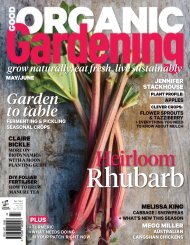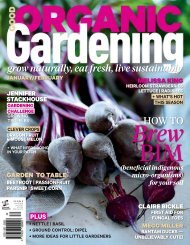5. Good Organic Gardening - September-October 2016 AvxHome.in
5. Good Organic Gardening - September-October 2016 AvxHome.in
5. Good Organic Gardening - September-October 2016 AvxHome.in
You also want an ePaper? Increase the reach of your titles
YUMPU automatically turns print PDFs into web optimized ePapers that Google loves.
Grow some different varieties<br />
and oddly shaped pumpk<strong>in</strong> that is more<br />
ornamental than edible.<br />
The comb<strong>in</strong>ation of a large sprawl<strong>in</strong>g size<br />
and a complement of large leaves on spiky<br />
stems makes pumpk<strong>in</strong>s less than ideal for<br />
conta<strong>in</strong>er grow<strong>in</strong>g, but there are small, bushy<br />
varieties such as ‘Golden Nugget’ that can be<br />
grown successfully <strong>in</strong> a conta<strong>in</strong>er or raised<br />
garden bed. They produce small, squash-like<br />
orange pumpk<strong>in</strong>s.<br />
Troubleshoot<strong>in</strong>g<br />
Apart from a susceptibility to mildew, which<br />
is a family fail<strong>in</strong>g for members of the cucurbit<br />
family, pumpk<strong>in</strong>s are disease free. Mildew may<br />
occur late <strong>in</strong> the grow<strong>in</strong>g season when plants<br />
are ready to be removed.<br />
Pumpk<strong>in</strong> beetle may also feed on the<br />
foliage of pumpk<strong>in</strong>s, often skeletonis<strong>in</strong>g the<br />
leaves but rarely damag<strong>in</strong>g the flowers or<br />
fruit. The easiest way to control this pesky<br />
beetle is by squash<strong>in</strong>g the adults and young.<br />
The 28-spotted ladybird, which is a<br />
leaf-eat<strong>in</strong>g ladybird and one of the few that<br />
damage plants, may also attack pumpk<strong>in</strong><br />
leaves <strong>in</strong> summer and early autumn. To reduce<br />
pest numbers, squash the ladybirds and their<br />
eggs, which are found under the foliage.<br />
The fruits may be attacked by rodents,<br />
especially mice, which gnaw on the sk<strong>in</strong> and<br />
can damage the fruit so it can’t be stored.<br />
To keep mice away from pumpk<strong>in</strong>s, make a<br />
protective cage or enclosure around fruits.<br />
Birds and bees<br />
Pumpk<strong>in</strong> flowers are either male or female<br />
and both are needed for fruit<strong>in</strong>g. Although<br />
both flowers are golden yellow, they are easy<br />
to tell apart as the male flower has pollencoated<br />
stamens and is held on a narrow stem<br />
while the female has a s<strong>in</strong>gle sticky pistil<br />
<strong>in</strong>side the flower, which has a swollen base<br />
under the bloom that becomes the fruit.<br />
The male flowers produce pollen that<br />
fertilises the female blooms, which can then<br />
form the pumpk<strong>in</strong> we eat. Bees and other<br />
poll<strong>in</strong>at<strong>in</strong>g <strong>in</strong>sects carry pollen from one<br />
flower to another. Fresh flowers open each<br />
day and usually nature gets it right, so there<br />
are enough male flowers around as well as<br />
bees to poll<strong>in</strong>ate that day’s crop of female<br />
flowers. However, as the flowers are generally<br />
only open for a day, tim<strong>in</strong>g is critical.<br />
Sometimes nature doesn’t get it right.<br />
There may be a lack of boy flowers when<br />
all the girls are flower<strong>in</strong>g or vice versa, or<br />
the bees may be tardy. Often male flowers<br />
are prevalent early <strong>in</strong> the season or when<br />
the weather is cool, with the female flowers<br />
bloom<strong>in</strong>g later as summer temperatures<br />
Pumpk<strong>in</strong> | TIME TO PLANT<br />
Grow<strong>in</strong>g them<br />
aga<strong>in</strong>st a fence, shed<br />
or other support<br />
can reduce the<br />
horizontal space they<br />
need as they can be<br />
encouraged to climb.<br />
warm up. Tip prun<strong>in</strong>g a vigorously grow<strong>in</strong>g<br />
pumpk<strong>in</strong> v<strong>in</strong>e can encourage more side<br />
growth, which can lead to the production of<br />
more female flowers. Usually, just wait<strong>in</strong>g for<br />
warmer weather br<strong>in</strong>gs a balance of male and<br />
female blooms and lots of fruit.<br />
When the bees aren’t do<strong>in</strong>g their job, help<br />
your crop along by hand poll<strong>in</strong>at<strong>in</strong>g. This<br />
<strong>in</strong>volves transferr<strong>in</strong>g pollen from a male flower<br />
to a female one us<strong>in</strong>g a small, dry pa<strong>in</strong>tbrush<br />
or cotton bud. If male flowers are scarce,<br />
collect pollen from those that are open to<br />
use the next day to fertilise a bevy of female<br />
flowers that get their tim<strong>in</strong>g wrong. Save<br />
pollen <strong>in</strong> an airtight conta<strong>in</strong>er.<br />
Harvest<strong>in</strong>g &<br />
stor<strong>in</strong>g<br />
Pumpk<strong>in</strong>s are ready to harvest <strong>in</strong> autumn<br />
when the fruit is large and heavy. Expect the<br />
fruit to take around 14–16 weeks to reach<br />
maturity, depend<strong>in</strong>g on the variety and<br />
grow<strong>in</strong>g conditions. The colour may change<br />
as the pumpk<strong>in</strong> ripens and it should sound<br />
drummy when rapped with your knuckles.<br />
To harvest, cut the pumpk<strong>in</strong> from the<br />
v<strong>in</strong>e, leav<strong>in</strong>g a portion of stem attached.<br />
Allow the sk<strong>in</strong> to “cure” or harden <strong>in</strong> the<br />
sun for a week or so but don’t expose it to<br />
frosty conditions. Undamaged pumpk<strong>in</strong>s<br />
can be stored <strong>in</strong> a cool, airy spot for several<br />
months. Check stored fruit regularly,<br />
monitor<strong>in</strong>g for rots or damage (for example,<br />
that caused by rodents).<br />
Pumpk<strong>in</strong> label<br />
Common name: Pumpk<strong>in</strong>, w<strong>in</strong>ter squash<br />
Botanical name: Cucurbita maxima<br />
Family: Cucurbitaceae<br />
Aspect and soil: Sun; deep, moist,<br />
fertile soil<br />
Best climate: All, but grow <strong>in</strong> the<br />
warmest part of the year<br />
Habit: Annual v<strong>in</strong>e<br />
Propagation: Seed, seedl<strong>in</strong>g<br />
Difficulty: Easy<br />
<strong>Good</strong> <strong>Organic</strong> <strong>Garden<strong>in</strong>g</strong> | 41

















